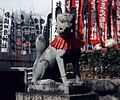Inari (mythology) facts for kids

Inari Ōkami (稲荷大神, also Oinari) is a very important kami (a Japanese god or spirit). Inari is known as the god of foxes, fertility, and rice. This spirit also looks after tea and sake (a Japanese drink). Inari is also connected to agriculture and industry. Many people pray to Inari for general prosperity and success in life.
In the past, Inari was also seen as the protector of swordsmiths and merchants. Inari can be shown as a male or female spirit. Sometimes, Inari is even seen as a group of three or five different kami. People have worshipped Inari since at least 711 AD. Some experts think the worship started even earlier, around the late 400s.
Inari's History and Popularity
Worship of Inari became very popular across Japan during the Edo period (1603-1868). By the 1500s, Inari was known as the protector of blacksmiths and warriors. Inari is a popular figure in both Shinto and Buddhist beliefs in Japan.
Many shrines in Japan are dedicated to Inari. More than one-third of all Shinto shrines, about 32,000, honor Inari. Even today, some modern companies respect Inari as a patron spirit. For example, the cosmetic company Shiseido has shrines on top of their main buildings.
Inari's Messengers: Kitsune
Inari's special helpers are their foxes, called kitsune. These foxes are usually shown as pure white. They act as messengers for Inari. You can often see statues of these white foxes at Inari shrines. Many of these statues wear red bibs, which are offerings from people.
Images for kids
-
Statue of a kitsune adorned with a red votive bib in a shrine at Inuyama Castle. Many castles in Japan contain Inari shrines.
-
Red torii along a path at the Fushimi Inari shrine in Fushimi-ku, Kyoto.
See also
 In Spanish: Inari (Japón) para niños
In Spanish: Inari (Japón) para niños








